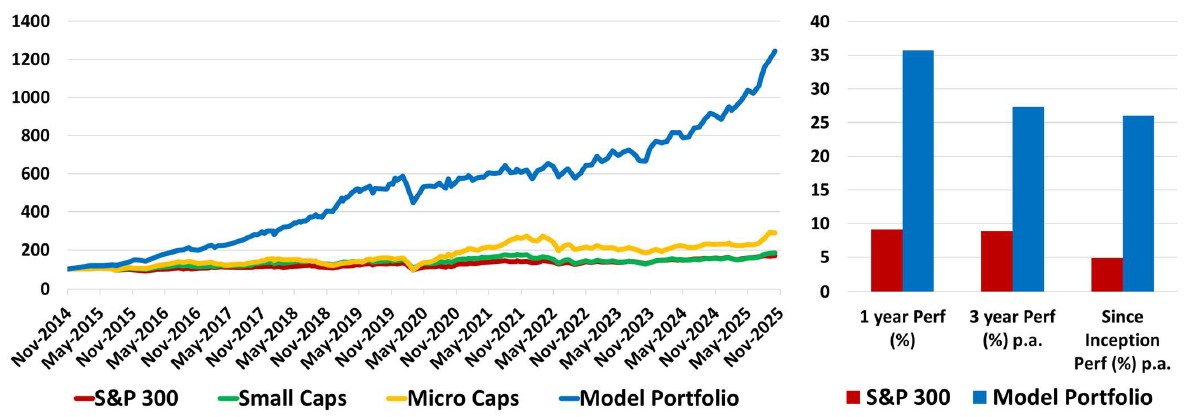Growth at reasonable yield (GARY) shows how the bear outperformed the bulls in a bull market
Some in the market jokingly call me the “last bear standing,” but the reality is simpler: we focus on disciplined, risk-managed active investing. The broader macro picture remains weak, policy missteps are adding up, and key data continues to point toward a challenging cycle.
Despite this, markets are pressing higher as active managers chase momentum amplified by heavy global passive inflows boosting multiples. In an environment like this, being bearish for the sake of it serves no purpose. What matters is positioning — building a strategy designed to benefit from the cycle rather than fear it.
Investors still need returns, and today’s macro backdrop calls for thoughtful risk management. That’s where GARY stands out, consistently delivering strong outperformance while keeping risk at the center of the process.
After all, there’s no point forecasting the big rain if you haven’t built the ark. Let’s stay prepared — and stay ahead.
Macro Cycles
The local market ended October with its weakest week since April’s “Liberation Day” tariff shock, capping off a volatile month marked by geopolitical flare-ups, trade setbacks, and policy reversals. Recent developments across global fronts offered no clear direction, only reinforcing investor caution.
On the geopolitical side, Russian sanctions are losing their bite while Ukraine’s drone strikes on Russian trade infrastructure are becoming increasingly effective. Meanwhile, the latest round of US–China trade tensions fizzled out quickly. China secured a series of policy wins — commonly dubbed “TACOs” (Trump Always Chickens Out) — while offering little in return. Despite the noise surrounding rare earths and critical minerals, the core bottleneck remains unchanged: processing, not access. Rare earths themselves aren’t scarce, but China’s dominance in processing can’t be recreated overnight, no matter how much capital the US throws at the challenge.
Beijing’s negotiating posture underscored this advantage. The US entered talks aggressively and exited with little progress to show; China didn’t even request access to Nvidia AI chips, signaling confidence in its own technological trajectory. The contrast in approach was clear — China arrived with preparation and strategy, while the US leaned on political theatre.
Domestic politics in Washington added further uncertainty. The government shutdown drags on, with public sentiment increasingly shifting toward Democrats amid proposed healthcare and welfare cuts. In parallel, the US has issued fresh threats toward Venezuela and Nigeria — both resource-rich nations — reflecting a familiar pattern where vested interest groups circle opportunities created by US-driven instability.
Against this backdrop, global inflation continues to climb through a heavily indebted economic system, while growth momentum weakens. Investors face a challenging landscape defined by policy missteps, unwinding asset bubbles, and heightened geopolitical tension — with uncertainty likely to deepen in the weeks ahead.
Pundits call me the “last bear standing”. We run a strategy of risk managed active investing. The big picture data continues to remain negative and policy failures are mounting. Markets are ignoring risks due to the need of active fund managers chasing the market being boosted by global passive fund flows. There is no point being bearish, if we do not target our strategy to benefit from the cycle. Investors need returns and the current macro deserves risk management. GARY delivers substantial outperformance with risk management. There is no point predicting the big rain if you don’t build an ark.
Policy Outlook
The US Fed led the central bank narrative by signaling that future rate cuts are not guaranteed, citing rising inflation and a resilient labour market. As economic momentum slows and tariff-driven inflation picks up, pressure from the White House on the Fed is expected to intensify. The RBA was anticipated to cut rates, but a stronger-than-expected inflation and strong employment data shifted that outlook. The RBA may have finished with rate cuts in the current cycle while maintaining a cautious stance amid inflation risks.
Data Analytics and AI takeaway
The preferred investment factors continue to remain with inflation, value, dividend yield, profitability and size. Elevated economic stress is starting to show around the world with stagflation worries rising.
Investment Strategy
Yield investing in today’s high-risk macroeconomic environment requires a data-driven, balanced approach—especially as US policy decisions continue to fuel inflation and interest rate uncertainties. Factors such as weaker government spending, shifting policies, and geopolitical tensions have heightened economic volatility, making the Federal Reserve’s hawkish stance on interest rates a key driver of fixed-income investments and yield-bearing assets.
In this landscape, investors face a critical challenge: balancing income generation with capital preservation. While high-yield bonds and dividend-paying stocks offer attractive returns, they also come with heightened exposure to market fluctuations and default risks. Meanwhile, conservative options like Treasury bonds provide stability but may struggle to keep pace with inflation, particularly if price pressures intensify.
The Growth at Reasonable Yield (GARY) strategy remains a compelling approach in this uncertain environment, catering to investors seeking a balance between income and risk management. By prioritizing adaptability and strategic positioning, Deep Data Analytics’ GARY strategy delivers consistent premium outperformance over the long term—helping investors navigate elevated interest rates, slowing growth, and geopolitical uncertainty with confidence.
Portfolio Strategy
Global markets remain suspended in an inflated asset bubble, sustained largely by passive global fund flows even as underlying fundamentals continue to weaken. Growth momentum is slowing across major economies, while inflation pressures are building again and proving harder to contain.
Trade tensions are adding further strain. The US-led trade wars and ongoing geopolitical maneuvering—often used to distract from domestic economic fragility—are instead amplifying it. A series of abrupt policy reversals is eroding investor confidence, stalling growth, and allowing inflation to become more entrenched. While Washington’s strategic focus remains on containing China, Beijing entered this phase far better prepared, and the resulting tariff-driven cost pressures are now filtering through supply chains as companies run down inventories and work to defend margins.
The AI-led tech rally is also revealing early signs of fatigue. Consumer-facing revenues remain too thin to justify extreme valuations, leaving mega-cap names increasingly reliant on cross-investment to keep sentiment afloat.
Monetary policy is offering little relief. The US Federal Reserve and the RBA have both deferred rate-cut expectations in response to renewed inflation pressures—moves that risk inflating asset bubbles even further.
With no meaningful policy shifts emerging across major economies, our positioning remains consistent: focus on inflation-linked sectors and maintain elevated risk-management settings as volatility builds.
Model Portfolio
The best performers over the last three months in the Growth at Reasonable Yield (GARY) Top 10 are: Codan (ASX:CDA), Dicker Data (ASX: DDR), Evolution (ASX: EVN), and Regis Resources (ASX: RRL).

Note: DDA may or may not have made changes to the model holdings since end of October update. The data driven model portfolios will continue to evolve with the economic and market cycles.
5 topics
4 stocks mentioned

